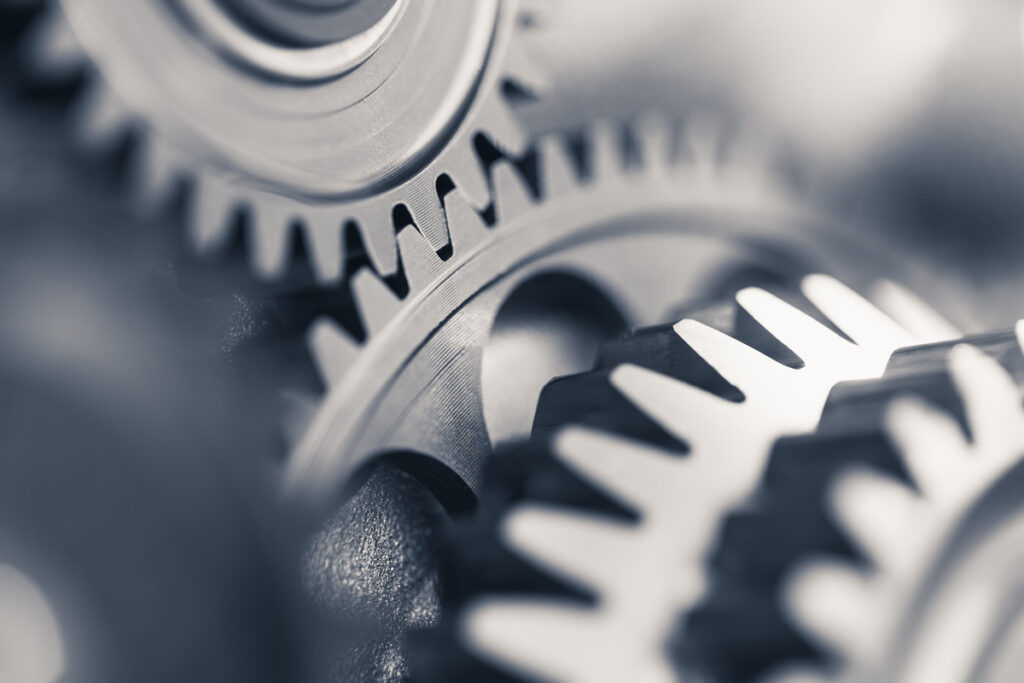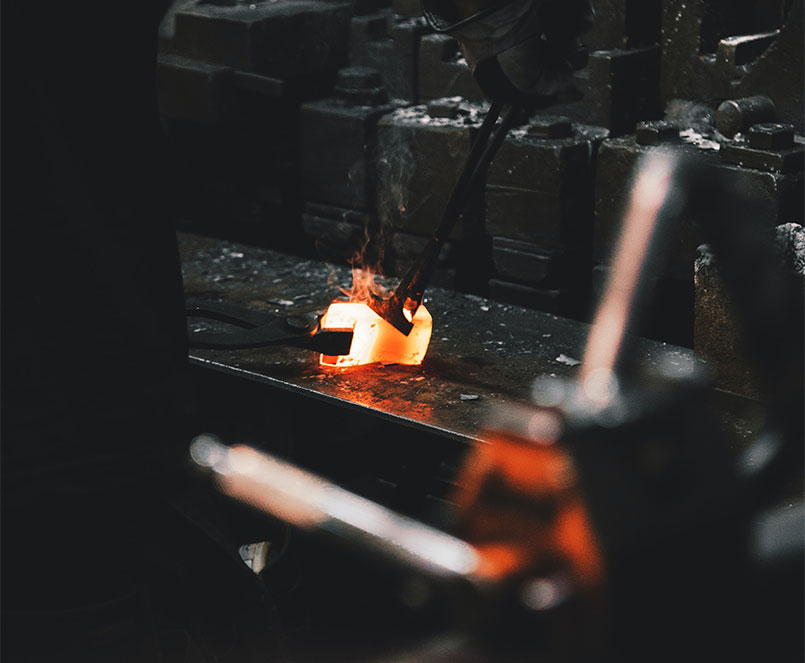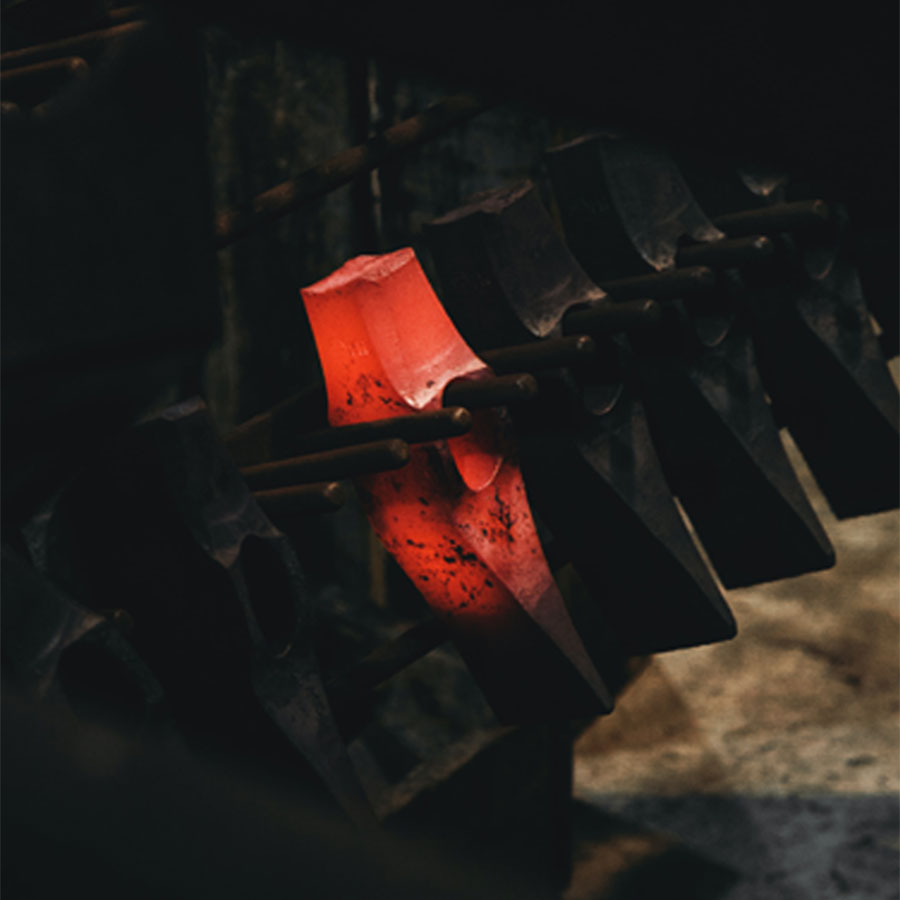
About the industry
Different technical approaches and methods – one goal
History of metal forming
Before mankind started to use fire for its own purposes, it was a threat representing uncontrollable destruction. People tried to find an explanation for fire-spitting volcanoes and lightning strikes and attributed the natural phenomena to the wrath of the gods or the work of superior forces. It was not until fire was tamed for use that the cultural history basis for technical development was laid. Fire was initially a source of heat, protection against wild animals or a means for preparing food. People soon found out that metals like gold, silver, copper, lead and pewter could be shaped with fire. An important prerequisite for the evolution of the craft of forging – and for today’s use of computer-calculated forging parts.
„Forging” is the generic term for all methods to form metal workpieces with pressure. The forging of metals is one of the oldest working techniques of mankind. For millennia it has been an essential prerequisite for the introduction of improved cultivation methods, the development of crafts and trades, the production of devices and weapons and for the progression of mobility and power transmission.


Where to find applications of forgings
Forgings are failure-safe and reliable components due to their favorable material properties, the high repeatability of the process during their production, as well as the good testing possibilities. They are implemented anywhere where reliability and service life at high power density or high stresses play an important role. The main applications are as follows:
Automotive and Truck
In automotive and truck applications, forged components are commonly found at points of shock and stress. Cars and trucks may contain more than 250 forgings, most of which are produced from carbon or alloy steel.
Aerospace
High strength-to-weight ratio and structural reliability improve performance, range, and payload capabilities of aircraft. That’s why ferrous and nonferrous forgings are used in helicopters, piston-engine planes, commercial jets, and supersonic military aircraft. Many aircraft are “designed around” forgings, and contain more than 450 structural forgings as well as hundreds of forged engine parts.
Off-Highway and Agricultural
Strength, toughness, machinability, and economy account for the use of ferrous forgings in off-highway and heavy construction equipment, and in mining machinery.
Renewable energy
Renewable sources of energy – wind power, solar power (thermal, photovoltaic and concentrated), hydro-electric power, tidal power, geothermal energy and biomass – are essential alternatives to fossil fuels. Their use reduces our greenhouse gas emissions, diversifies our energy supply and reduces our dependence on unreliable and volatile fossil fuel markets (in particular oil and gas). The growth of renewable energy sources also stimulates employment in Europe, the creation of new technologies and improves our trade balance.
Valves and Fittings
For valves and fittings, the mechanical properties of forgings and their freedom from porosity are especially suited to high-pressure applications.
Industrial, Hardware and Tools
“Forged” is the mark of quality in hand tools and hardware. Strength, resistance to impact and fatigue, and excellent appearance are reasons why forgings have been the standard of quality since the earliest of times. The same is true of surgical instruments. Special hardware for electrical transmission and distribution lines is subject to high stresses and corrosion.

Benefits of Forgings
Since its beginnings 10,000 years ago forging has assured highest performance, reliability, sustainability and economic efficiency in a wide variety of products and parts. Today, these advantages of forged components assume greater importance as operating circumstances, loads and environmental as well as economic requirements increase.
Highest performance
- Forged components ensure extreme impact strength, particularly in applications with high fatigue and high contact stresses. Their toughness prevents ductile-brittle transition problems and multiply their performance.
Longest Reliability
- The construction of forged components allows an uninterrupted fibre flow, which leads to structural reliability. This and their freedom from porosity are especially suited to high-pressure applications.
Best Sustainability
- Their outstanding mechanical features lead to a perfect strength-to-weight ratio which enables lightweight construction. Forging components are extremely long lasting and 100% recyclable. The Forging Carbon Footprint is lower than that of competing metalworking technologies.
Economic efficiency
- One million parts – no failure! Forging is ideal for large production volumes as it guarantees constant quality and low total costs.
Benefits of Forgings

Since its beginnings 10,000 years ago forging has assured highest performance, reliability, sustainability and economic efficiency in a wide variety of products and parts. Today, these advantages of forged components assume greater importance as operating circumstances, loads and environmental as well as economic requirements increase.
Highest performance
- Forged components ensure extreme impact strength, particularly in applications with high fatigue and high contact stresses. Their toughness prevents ductile-brittle transition problems and multiply their performance.
Longest Reliability
- The construction of forged components allows an uninterrupted fibre flow, which leads to structural reliability. This and their freedom from porosity are especially suited to high-pressure applications.
Best Sustainability
- Their outstanding mechanical features lead to a perfect strength-to-weight ratio which enables lightweight construction. Forging components are extremely long lasting and 100% recyclable. The Forging Carbon Footprint is lower than that of competing metalworking technologies.
Economic efficiency
- One million parts – no failure! Forging is ideal for large production volumes as it guarantees constant quality and low total costs.